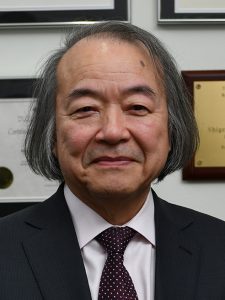Dermot McGrath
Published: Thursday, December 3, 2020

Shigeru Kinoshita MD, PhD
Injection of cultured human corneal epithelial cells (hCECs) supplemented with a rho-associated protein kinase (ROCK) inhibitor into the anterior chamber may offer a potentially groundbreaking new treatment for corneal endothelial dysfunction, according to Shigeru Kinoshita MD, PhD.
“This injected cell therapy holds a lot of promise for corneal endothelial cell disorders such as Fuchs’ endothelial corneal dystrophy. Initial studies have shown minimal immunological reaction, normal corneal configuration and rejuvenated endothelial cells after injection of hCECs in a series of bullous keratopathy patients,” said Dr Kinoshita at the World Ophthalmology Congress 2020 Virtual.
Dr Kinoshita’s research group at the Kyoto Prefectural University of Medicine, Kyoto, Japan, has been working for some years on hCEC injection therapy using donor allogenic cells.
“The interest of this is that conceptually, just one donor cornea could be sufficient to create cells for up to 1,000 patients in a safe, quick and easy procedure,” said Dr Kinoshita.
Dr Kinoshita explained that human CEC cultures comprise a plurality of subpopulations, some of which are unsuitable and unsafe for injection into human eyes.“Our research has led us to understand that mature fully differentiated cells hold the key to a successful and safe treatment,” he said.
Surveying the clinical research data, Dr Kinoshita said that his team has now injected hCECs in about 65 patients overall with very good safety and efficacy outcomes.
The most recent single-group study involved 11 patients who had received a diagnosis of bullous keratopathy and had no detectable CECs. The patients received injections in the anterior chamber of hCECs cultured from a donor cornea and supplemented with a ROCK inhibitor. Immediately after the procedure, the patients were placed in a prone position for three hours in order to enhance the adhesion of the injected cells.
The results at 24 weeks showed that the injection therapy was effective, with repopulation of CECs on Descemet’s membrane and the posterior surface of the corneal stroma, attainment of normal corneal thickness and resolution of corneal epithelial oedema.
“The visual acuity of many of the patients also improved significantly and the corneas were still transparent up to two years after surgery,” added Dr Kinoshita.
Shigeru Kinoshita: shigeruk@koto.kpu-m.ac.jp
Tags: cell therapy, corneal endothelial dysfunction
Latest Articles
Beyond the Numbers
Empowering patient participation fosters continuous innovation in cataract surgery.
Read more...
Thinking Beyond the Surgery Room
Practice management workshop focuses on financial operations and AI business applications.
Read more...
Picture This: Photo Contest Winners
ESCRS 2025 Refractive and Cataract Photo Contest winners.
Read more...
Aid Cuts Threaten Global Eye Care Progress
USAID closure leads retreat in development assistance.
Read more...
Supplement: ESCRS Clinical Trends Series: Presbyopia
Read more...
Nutrition and the Eye: A Recipe for Success
A look at the evidence for tasty ways of lowering risks and improving ocular health.
Read more...
New Award to Encourage Research into Sustainable Practices
Read more...
Sharing a Vision for the Future
ESCRS leaders update Trieste conference on ESCRS initiatives.
Read more...
Extending Depth of Satisfaction
The ESCRS Eye Journal Club discuss a new study reviewing the causes and management of dissatisfaction after implantation of an EDOF IOL.
Read more...
Conventional Versus Laser-Assisted Cataract Surgery
Evidence favours conventional technique in most cases.
Read more...

 Shigeru Kinoshita MD, PhD
Shigeru Kinoshita MD, PhD